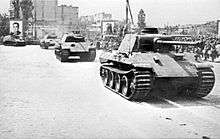Tudor Vladimirescu Division

The Tudor Vladimirescu Division (full name: Romanian 1st Volunteer Infantry Division 'Tudor Vladimirescu - Debrecen' ) was a Soviet-organized division of Romanians that fought against Germany and Hungary during the final year of World War II.
Creation
Named for the leader of an uprising in Wallachia in 1821, the division was formed from Romanian prisoners of war in October 1943,[1] under the command of Brigadier General Nicolae Cambrea. Although termed 'volunteers', the bulk of the men likely volunteered in order to escape a desperate existence in Soviet POW camps. The Tudor Vladimirescu Division was organized and equipped like a Soviet rifle (infantry) division.
Wartime service
The division marched into Bucharest on August 29, 1944, ostensibly as liberators, but the city had in fact already been liberated by units of the Romanian Army when Romania left the Axis Powers and attacked German troops stationed in the country.[2]
The division, still under Soviet control, saw real combat during the final months of the war in Transylvania, Hungary, and Czechoslovakia, playing a key role in the Soviet seizure of Debrecen, Hungary, in October 1944. Combat losses were heavy; by March 1945 the strength of the division had sunk to 4,436 men.[3]
In March 1945 the division was pulled out of the front lines, but remained under the operational control of the 2nd Ukrainian Front until August 15, 1945.[3]
Postwar political role
Relentlessly politicized by their communist leaders, the Tudor Vladimirescu Division became a politically reliable military formation of the Romanian communists. Along with another Romanian communist unit, the Horia, Cloşca şi Crişan Division, and backed by tens of thousands of Red Army troops, the Tudor Vladimirescu Division played a key role in imposing communist rule in Romania after the war. The two communist divisions were integrated into the Romanian Army on August 22, 1945. The Tudor Vladimirescu Division was converted into an armored division by 1947 while the regular Romanian army was reduced to four divisions[4] with no tanks, thus providing the Romanian communists the trump cards of mobility and firepower had a conflict with anti-communist elements in the Romanian Army taken place.
The Division was converted into the 1st Armored Division in 1947, then 5 Tank Corps, after 47 Tank Corps, and finally take the name of 37 Mechanised Division, which became in 1957 a Mechanised Division.
In the 1950s Soviet officers were employed as advisors. Order subunits (battalions, companies) was matched by political officers. After 1956-1957 the youth division officers were assigned to three years in military school or other schools in Sibiu.
Footnotes
Sources
- The Romanian Army of World War 2, Mark Axworthy and Horia Serbanescu, London: Osprey, 1991. ISBN 1-85532-169-6.
- Stalins Fremde Heere, Peter Gosztony, Bonn: Bernard & Graefe Verlag, 1991. ISBN 3-7637-5889-5.